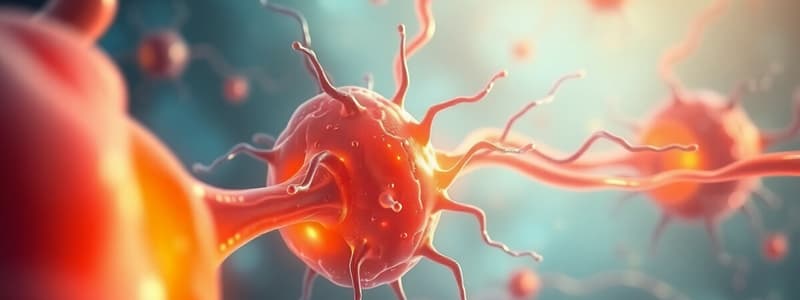Podcast
Questions and Answers
What two primary factors determine the onset of action for local anesthetics?
What two primary factors determine the onset of action for local anesthetics?
- Vessel dilation and tissue pH
- Protein binding and molecular weight
- Lipid solubility and sodium channel interaction (correct)
- Metabolism rate and excretion rate
How does a lower pH environment typically affect the tissue penetration of a local anesthetic?
How does a lower pH environment typically affect the tissue penetration of a local anesthetic?
- Enhances tissue penetration
- Increases the rate of metabolism
- Has no effect on tissue penetration
- Reduces tissue penetration (correct)
What property of local anesthetics is reflected by their potency?
What property of local anesthetics is reflected by their potency?
- Ability to cause vasodilation
- Excretion rate via the kidneys
- Degree of sodium channel interaction (correct)
- Rate of metabolism in the liver
Which characteristic of its molecular structure most significantly determines the potency of a local anesthetic?
Which characteristic of its molecular structure most significantly determines the potency of a local anesthetic?
What are the two primary processes by which the duration of action of a local anesthetic is determined?
What are the two primary processes by which the duration of action of a local anesthetic is determined?
How are ester-type local anesthetics primarily metabolized, and what is a characteristic of their half-life?
How are ester-type local anesthetics primarily metabolized, and what is a characteristic of their half-life?
Where does the metabolism of amide-type local anesthetics primarily occur?
Where does the metabolism of amide-type local anesthetics primarily occur?
Which of the following is a common method used to prolong the duration of action of a local anesthetic?
Which of the following is a common method used to prolong the duration of action of a local anesthetic?
Which clinical scenario might involve the use of local anesthetics administered topically or by injection to treat conditions affecting the ear, nose, and throat?
Which clinical scenario might involve the use of local anesthetics administered topically or by injection to treat conditions affecting the ear, nose, and throat?
EMLA cream, commonly used as a topical anesthetic, contains a mixture of what two local anesthetic agents?
EMLA cream, commonly used as a topical anesthetic, contains a mixture of what two local anesthetic agents?
A local anesthetic is administered via subcutaneous injection. What type of local anesthetic administration is this?
A local anesthetic is administered via subcutaneous injection. What type of local anesthetic administration is this?
Which type of peripheral nerve block involves multiple nerves or a plexus?
Which type of peripheral nerve block involves multiple nerves or a plexus?
For procedures involving the lower extremities, lower abdomen and pelvis, which type of local anesthetic administration is most likely to be used?
For procedures involving the lower extremities, lower abdomen and pelvis, which type of local anesthetic administration is most likely to be used?
Where are adrenaline/noradrenaline combinations cautioned to be avoided when using local anesthetics?
Where are adrenaline/noradrenaline combinations cautioned to be avoided when using local anesthetics?
Lignocaine is often combined with adrenaline for which routes of administration?
Lignocaine is often combined with adrenaline for which routes of administration?
What is a notable characteristic of bupivacaine regarding its onset and duration of action?
What is a notable characteristic of bupivacaine regarding its onset and duration of action?
Systemic absorption of local anesthetics can lead to adverse effects. Which of the following is a potential CNS effect?
Systemic absorption of local anesthetics can lead to adverse effects. Which of the following is a potential CNS effect?
Myocardial depression and vasodilation are cardiovascular effects of local anesthetics that may lead to what condition?
Myocardial depression and vasodilation are cardiovascular effects of local anesthetics that may lead to what condition?
Methemoglobinemia is a potential adverse reaction associated with large doses of which local anesthetic?
Methemoglobinemia is a potential adverse reaction associated with large doses of which local anesthetic?
Which local anesthetic is water insoluble and used ONLY for surface anesthesia?
Which local anesthetic is water insoluble and used ONLY for surface anesthesia?
Flashcards
Onset of Action (Local Anesthetics)
Onset of Action (Local Anesthetics)
The rate of tissue penetration and Na+ channel interaction; affected by lipid solubility and pKa.
Potency (Local Anesthetics)
Potency (Local Anesthetics)
Degree of Na+ channel interaction; determined by lipid solubility and alkyl chain substituents.
Ester-type Local Anesthetics
Ester-type Local Anesthetics
Hydrolyzed very rapidly in plasma by plasma esterases; possess very short half-life.
Amide-type Local Anesthetics
Amide-type Local Anesthetics
Signup and view all the flashcards
Increasing Duration of Action
Increasing Duration of Action
Signup and view all the flashcards
Types of Local Anesthetic Application
Types of Local Anesthetic Application
Signup and view all the flashcards
Lignocaine
Lignocaine
Signup and view all the flashcards
Bupivacaine
Bupivacaine
Signup and view all the flashcards
Adverse Effects of Local Anesthetics
Adverse Effects of Local Anesthetics
Signup and view all the flashcards
Procaine
Procaine
Signup and view all the flashcards
Study Notes
- Local anesthetics affect nerve signal transmission, causing temporary numbness or loss of sensation in specific body areas.
Pharmacology of Local Anesthetics
- Onset of action depends on tissue penetration rate and interaction with sodium channels, influenced by lipid solubility and pKa.
- Lower pH reduces tissue penetration, delaying onset.
- Potency is linked to the degree of sodium channel interaction and is determined by lipid solubility and the structure of the alkyl chain substituents on the aromatic ring.
- Bupivacaine is four times more potent than lidocaine.
- Duration of action is affected by the metabolism and excretion rate.
Types of Local Anesthetics
- Ester types are rapidly hydrolyzed in the plasma by esterases, leading to a very short half-life.
- Amide types are metabolized in the liver, resulting in longer but variable half-lives.
- Metabolites are excreted via the kidneys in the urine.
- Increasing the dose or adding a vasoconstrictor agent such as adrenaline can extend the duration of action.
Local Anesthetic Drugs
- Procaine has a moderate onset, short duration, and slow tissue penetration with a plasma half-life of 30 minutes.
- Lidocaine has a rapid onset, moderate duration, and rapid tissue penetration with a plasma half-life of 2 hours.
- Amethocaine has a slow onset, long duration, and moderate tissue penetration with a plasma half-life of 1 hour.
- Dibucaine has a moderate onset, long duration, and moderate tissue penetration with a plasma half-life of 3 hours.
- Bupivacaine has a slow onset, long duration, and moderate tissue penetration with a plasma half-life of 3 hours.
- Prilocaine has a moderate onset, moderate duration, and moderate tissue penetration with a plasma half-life of 2 hours.
- Procaine was the first synthetic local anesthetic.
- Benzocaine is water-insoluble and used only for surface anesthesia.
- Lidocaine is used with adrenaline for epidural and spinal anesthesia and is used for surface anesthesia (2-4%) in creams, gels, ointments, solutions, and sprays
- Bupivacaine has a slow onset but a long duration of action and is used for nerve block anesthesia, epidural anesthesia in labor, and spinal anesthesia.
- Prilocaine is low in toxicity and can be administered through most routes.
General Clinical Use of Local Anesthetics
- Used as antipruritics for conditions like hemorrhoids.
- Used in skin biopsies.
- Used for investigation and treatment of conditions affecting the ear, nose, and throat, administered topically or by injection.
- Used for investigation and treatment of eye conditions.
- Used for treating painful conditions of the mouth and throat.
- Used in gynecological procedures.
- Useed for examination and surgical procedures on the urinary tract.
Types of Local Anesthetic Applications
- Topical application includes skin applications (like EMLA cream, a mix of lidocaine and prilocaine, and AMETOP gel, which contains 4% amethocaine).
- Topical application over mucous membranes of the nose, mouth, bronchial tree, esophagus, and genitourinary tract.
- Infiltration includes subcutaneous injection.
- Peripheral nerve block where minor affects a single nerve, and major affects multiple nerves or a plexus.
- Spinal application includes lower extremities, lower abdomen, and pelvis.
- Epidural application includes cervical, thoracic, lumbar, and caudal areas of the spine.
Adverse Effects of Local Anesthetics
- Adverse effects are caused by drugs entering the systemic circulation.
CNS Effects
- CNS effects include agitation, confusion, tremors, convulsions, and respiratory center depression.
Cardiovascular Effects
- Cardiovascular effects include myocardial depression and vasodilation, which can lead to hypotension and possible cardiac arrest.
- Hypersensitivity reactions are rare but can cause allergic dermatitis and mucosal irritation.
- Methaemoglobinaemia from large doses of prilocaine in rare cases
Precautions When Using Local Anesthetics
- Combinations of adrenaline/noradrenaline should not be used where circulation may be compromised by vasoconstriction, such as in fingers, toes, ears, nose, or penis.
Studying That Suits You
Use AI to generate personalized quizzes and flashcards to suit your learning preferences.



